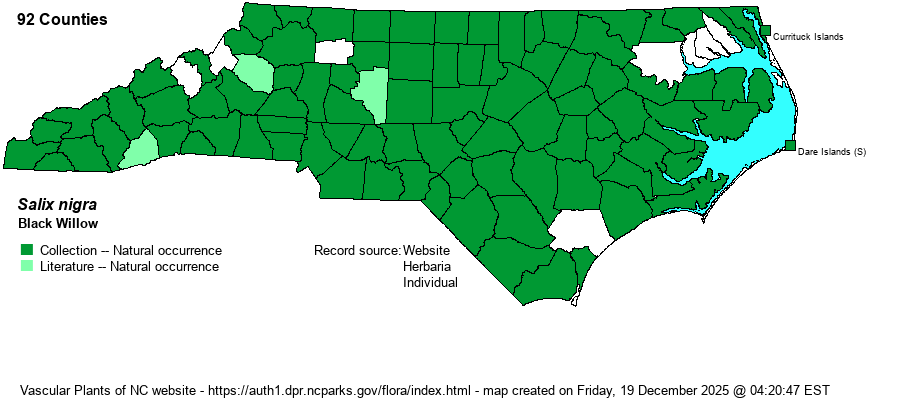| Author | Marshall | |
| Distribution | Occurs statewide, and likely is present in all 100 counties. However, few records for the extreme northeastern corner of the state.
Ranges across essentially all of eastern North America, from southern Canada to northern FL, and west to eastern NM and MN.
| |
| Abundance | Common and widespread across the entire state, though seemingly less common in the northeastern corner; no records yet for Camden, Pasquotank, Perquimans, and Chowan counties? Apparently rare in this region north of Albemarle Sound. Definitely the most numerous willow species in NC. | |
| Habitat | This is an easily found species of sunny to partly sunny wetlands, such as regenerating floodplains, wet thickets, sandbars, lake and pond margins, ditches and canal banks, and other somewhat early succession wetlands. It grows in similar habitats to S. caroliniana and S. sericea. |
| Phenology | Blooms and fruits in March and April. As with other willows and cottonwoods, the fluffy white “feathery” fruits are often seen floating through wetland habitats in spring. As this is such a common species, more often than not, such “snow” belongs to Black Willow more than to other species in the family (Salicaceae). | |
| Identification | This is a familiar, small deciduous tree, usually 30-40 feet tall, rarely to 60 feet tall. The leaves are very narrow and lanceolate in shape, often 10x longer than wide. The leaves, averaging 3-4 inches long, are green to somewhat pale green below, but not whitish as in the similar S. caroliniana or S. sericea. A tree-sized willow in the mountains and nearly all of the Piedmont will be this species – assuming you exclude the exotic Weeping Willow (S. babylonica), because Silky Willow (S. sericea) is just a shrub. However, be careful with willow identification in the Coastal Plain and lower Piedmont, as Coastal Plain Willow (P. caroliniana) is a tree and is not scarce. Make sure the leaves are not white below to call it a Black Willow. | |
| Taxonomic Comments | None
The genus Salix is a very large and complex group of plants that vary from ground-hugging Arctic belly plants to huge trees. There are 113 species in North America alone, including introduced species. They are extremely important to browsing mammals -- rabbits, deer, elk, muskox, moose, many rodents -- and browsing birds like ptarmigan. Many birds use them to nest in. Here in NC we only have a small number of native species (5) and so do not appreciate the ecological importance of willows. We highly recommend reading the introductory pages of George Argus's FNA treatment (2010) and his excellent monograph on the willows of the southeastern U.S. (1986). The latter has drawings and descriptions of all southeastern U.S. taxa. Due to natural and horticultural hybridization, some plants will not key cleanly and you may have to compare your specimen with others verified by Argus. | |
| Other Common Name(s) | None | |
| State Rank | S5 | |
| Global Rank | G5 | |
| State Status | | |
| US Status | | |
| USACE-agcp | OBL link |
| USACE-emp | OBL link |

